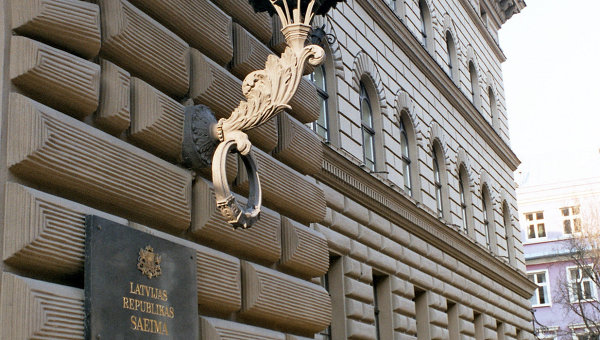
Realignments In Latvia’s Political Landscape Ahead of Crucial Elections (Part Two)
Publication: Eurasia Daily Monitor Volume: 8 Issue: 145
By:

Latvia is headed for pre-term parliamentary and presidential elections, potentially challenging the country’s strategic choices for the first time in two decades (see EDM, July 27). The political forces are grouped, broadly speaking, in three camps, none of them fully homogenous: parties of national-democratic and Western orientation, parties connected with business interests, and a major Russian party. Most parties are actually blocs, each comprised of several sub-parties.
In the current parliament of 100 seats, the Unity Bloc (leading the coalition government) holds 33 seats; the Russian party Harmony Center, 29 seats; the Latvian oligarch-connected parties, Greens and Farmers’ Union and For a Good Latvia, hold 22 and 8 seats, respectively; and the Latvian nationalist Fatherland and Freedom and All for Latvia, an aggregate of 8 seats.
The Unity Bloc, center-right and Western-oriented, continues to lead the incumbent government, pending the pre-term elections due in September. The bloc was formed in 2010 to run in that year’s parliamentary elections. Unity’s leaders were emblematic figures in the liberation movement of the late 1980s-early 1990s, and subsequently in bringing Latvia into NATO and the EU in 2004. The Unity Bloc includes three parties (led by traditional conservatives, modern conservatives, and social-liberals, respectively). They are not linked with business interest groups, adhere to free-market economics, and identify politically with nation-state interests.
Cooperating closely with President Valdis Zatlers, the Unity Bloc took office determined to break the hold of oligarchic interests on the political system. Under Prime Minister Valdis Dombrovskis it undertook to govern in the depths of economic crisis, raising taxes and cutting spending drastically. The Unity Bloc and Zatlers’s newly created party (see below) seem destined to continue cooperating after the elections.
Zatlers’ Reform Party was launched by the outgoing head of state on July 23, 2011 – the day of the referendum that overwhelmingly approved Zatlers’ initiative to dissolve the parliament and hold new elections. Head of state since 2007, and highly popular by the end of his first term in office, Zatlers lost his re-election bid narrowly in parliament. Oligarch-influenced parties and the Russian party joined forces to outvote Zatlers and the Unity Bloc for a second time in two months on a major decision, revealing the potential danger of a shift of power in Latvia. The outgoing president’s party seeks to prevent such a shift by capitalizing on Zatlers’ popularity, targeting primarily the uncommitted voters.
Its founding congress on July 23 defined Zatlers’s Reform Party as “centrist,” seeking to reconcile the free market with social solidarity. Decrying the “purchase of democracy” by business interests, this party draws a “red line” against cooperation with oligarch-financed parties. It calls for overcoming political divisions along ethnic lines, and it will reach out to Russian voters. However, it asks the Russian party, Harmony Center, to acknowledge the fact of the Soviet occupation, and to accept the status of the Latvian language as sole official language, among the conditions to any inter-party cooperation (BNS, LETA, July 23, 25).
Fatherland and Freedom and All for Latvia, two small nationalist parties in parliament, merged with each other into a National Alliance also on July 23, the date of the referendum and the launching of Zatlers’s party. Fatherland and Freedom’s roots go back to the liberation movement 20 years ago; whereas All for Latvia is a youth group founded in 2006. Traditionally, Fatherland and Freedom’s leaders (in and out of governments) favored liberal economics; whereas All for Latvia is more socially-oriented, and culturally conservative. Their respective leaders, Roberts Zile and Raivis Dzintars, are co-chairs of this new National Alliance. Both parties supported all along the Unity Bloc-led government, although they are not represented in it (Latvia in Review, July 25).
The Greens and Farmers’ Union and For a Good Latvia are linked with oligarchs’ interests. Businessmen Aivars Lembergs and Ainars Slesers, leaders of Latvia’s largest conglomerates, are widely reputed to influence or control the Greens-Farmers and Good Latvia, respectively. The Greens-Farmers or at least parts of it are a swing factor. They chose to pursue their interests through a tactical alliance with the Unity Bloc in 2010, as part of the Unity-led government. Since May of this year, however, the Greens-Farmers joined forces with the opposition and had this party’s candidate, Andris Berzins, elected as head of state (see above). For its part, Good Latvia is closely allied with the Russian party, Harmony Center, sharing control of the Riga City Council and other common interests.
Harmony Center has by now consolidated an overwhelming majority of the Russian (“Russian-speaking”) voters behind this party. Party leader Janis Urbanovics is an archetypal politician of the early post-Soviet years, with a style outmoded in Russia itself, but still effective with Russian voters in Latvia. Harmony is actually a bloc, but is not fully co-terminous with the Russian electorate. Riga mayor Nils Ushakovs, a telegenic youthful figure, has helped the party to make some small inroads among Latvian voters in the capital city. Conversely, a growing number of Russian voters approved of Zatlers’s presidential performance, and may defect from Harmony’s soft periphery to the Zatlers Party in the upcoming elections. But the phenomenon of ethnic, near-monolithic voting is deeply entrenched on the Russian side, and will almost certainly persist in these elections.
Harmony will receive an additional boost from the voters of more radical Russian groups, whom Harmony Center has managed to absorb in recent years. Moscow has discontinued its support for the radicals, consolidating the Russian vote behind Harmony Center, and hoping to insert the latter into a coalition government of Latvia. With Moscow’s full encouragement, Harmony leaders seek to project a more moderate image and qualify for joining a post-election government. Their declared maximum goal is to increase their parliamentary seats, from 29 at present to 40 seats, which would turn Harmony into the single largest parliamentary party and qualify it to nominate Latvia’s prime minister. But even a result somewhat under 40 seats could make it impossible for Latvia to form a government, without policy concessions to the Russian party and to Moscow. This might happen due to dispersion of votes among multiple Latvian parties, contrasting with nearly-monolithic Russian voting.




